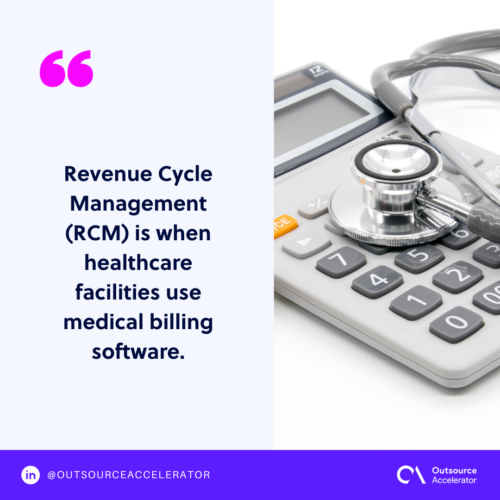A brief walkthrough of the revenue cycle management

The outsourcing industry caters to various types of industries. Any outsourcing service helps these sectors augment their overall efficiency and, more so, aid in their development.
Outsourcing is not just applicable to firms in the business segment. Instead, other sectors like the government, healthcare, or aviation can take full advantage of what its services have to offer.
Speaking of the healthcare industry, given its fast-paced and busy nature, outsourcing helps immensely improve workers’ productivity. Especially with the healthcare revenue cycle management.
The healthcare revenue cycle management helps alleviate the hard-pressed workload of healthcare workers and professionals, giving them more room to do other important things.
Revenue cycle management: The backbone of the healthcare industry
Revenue cycle management (RCM) is when healthcare facilities use medical billing software. This financial process allows these facilities to track all the patients’ activities, from registrations, appointments, and payments.
An RCM connects the business and clinical parts of the healthcare sector through its administrative data. This software’s primary role is communicating with a patient’s insurance company.
When insured patients undergo treatments or receive supplies, healthcare providers will classify them according to the International Classification of Diseases (ICD-10) codes.
The healthcare facility will then send the healthcare summary and the ICD and current procedural terminology (CPT) codes to the insurance companies.
From there, the insurance company will then determine which medical services are covered by the patient’s insurance. The patients themselves will then pay the remaining balance following the completion of medical billing processes.

Key elements of the revenue cycle management
Healthcare providers do not have that much control over the patients’ claim review and denial process payments. Thus, two elements drive the revenue cycle:
External factors
In some cases, claims and billings that take relatively long to process often result in rejection. It may be due to issues in insurance eligibility, fraud, healthcare regulations, or other reimbursement schemes.
Internal factors
Internal factors are composed of healthcare providers’ costs for particular procedures, services, or treatments. These patient service revenue elements also include the skills of the healthcare staff and front and back-office workflow.
Revenue cycle management process
An efficient healthcare revenue cycle management process consists of the following typical workflow:
Patient scheduling/pre-certification
The revenue cycle begins when a patient comes into a healthcare facility and undergoes pre-authorization. Insurance details, including demographic information, will be collected from the patient during this stage.
Eligibility and verification of insurance
Eligibility and verification take place before performing any services or procedures. A verification checklist tool is implemented into the RCM software to ensure all patients’ required information is collected and inspected.
Patients will also be made aware of the Explanations Of Benefits (EOB) statement. It is a detailed description of what their insurance company will cover on their behalf.
Charge and code
A set of codes is on record whenever a patient visits a healthcare facility. Professional medical coders are the people responsible for this task.
Further, all codes must follow the CPT guidelines and the updated ICD-10 coding system.
Deductibles and copayments
A deductible is a fixed amount in a health plan that patients must pay before the insurance company starts paying for the healthcare services or procedures.
Patients pay the copay at the healthcare facility after every appointment.
Submission of claims
During this stage, all claims will be filed to the insurance company through a clearinghouse. If the records are incorrect, it will lead to reduced payments or increased denials.
RCM begins as the healthcare facility’s management software, connecting internal processes with medical billing software. The billing company will then follow up with the insurance company for claims.
Payment posting/reimbursement
Payment posting is when the insurance company pays up. Once all bills are accurate, the reimbursement process will be smooth and hassle-free.
Denials usually happen when filed claims have incomplete information, erroneous claims, and more.
Manage denials
Rejected claims will be submitted again once they are cleared of coding errors. Resubmitted claims will be strictly screened under the latest coding guidelines.
If there are reimbursement cutbacks from the payers, the health plan will not cover all payments. It is now the role of the billers to send all outstanding payments to patients and follow up now and then until they pay up.

Importance of revenue cycle management
Good healthcare revenue cycle management helps healthcare providers maintain solid financial well-being. However, internal and external factors bring about such impacts on healthcare entities’ revenue and survival.
As a business entity, healthcare organizations should continuously optimize their RCM to help them with their transformational growth. And more than anything, provide total patient care to people in need.







 Independent
Independent




